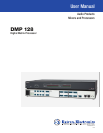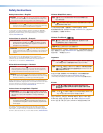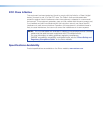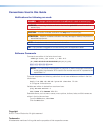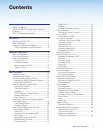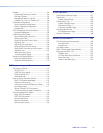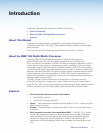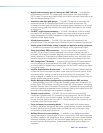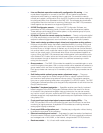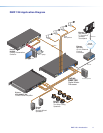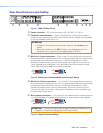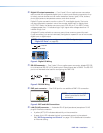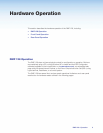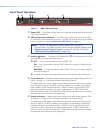
• Live and Emulate operation modes with configuration file saving — Live
mode allows integrators to connect to the DMP 128 and make live parameter
adjustments while hearing or metering them in real-time. This avoids the need to
compile and upload a configuration file to the DSP. Emulation mode allows settings to
be configured offline, then uploaded to the DMP 128. The software also downloads
configuration files from the mixer for archiving. Settings for two DMP 128 processors
linked together can be saved to a single configuration file.
• 32 DSP Configurator presets — Using the DSP Configurator Software, any
parameters for DSP processing, levels, or audio routing can be saved as presets.
These settings can be saved for the entire system, or any selected group of inputs,
outputs, mix-points, and DSP blocks.
• 20 digital I/O ports for remote control or feedback — Twenty configurable digital
I/O ports are provided, so that the DMP 128 can be programmed to sense and then
respond to external triggers such as mic activation, muting, and recall of presets.
• Triple matrix design provides output, virtual, and expansion routing options—
Employs a triple matrix design that offers substantial flexibility in routing, mixing, and
processing audio input sources. An output matrix allows any of the twelve inputs to
be mixed to any or all eight outputs. If desired, any of the inputs can first be directed
into a virtual matrix, which routes the inputs to eight virtual buses, before being mixed
back into the output matrix. Virtual buses allow inputs to be processed together as
a group. When two DMP 128 processors are linked together via the expansion ports
over shielded CAT 6 cable, inputs and virtual buses of one unit can be routed to the
other processor through an expansion matrix, for additional processing or matrix
mixing into the outputs.
• Group masters — The DMP 128 provides the capability to consolidate gain or mute
control throughout the system. Gain or mute controls can be selected and added to a
group master, which can then be controlled by a single master fader or mute control.
Each group master can have up to 16 members, and up to 32 group masters can be
created.
• Soft limits provide optimal group master adjustment range — The group
master volume range can be limited using soft limits to maintain optimal minimum
and maximum levels when using external volume control. This prevents operators
from over or under-adjusting levels when using digital I/O or RS-232 control. The DSP
Configurator Software provides quick drag-and-drop adjustment of soft limits from the
Group Controls screen.
• SpeedNav™ keyboard navigation — SpeedNav enables user-friendly, keyboard-
based navigation of the DSP Configurator Software without the need for a mouse
or touchpad. Using keyboard navigation keys and shortcuts, the user can access
any input or output, mix-point, and all audio DSP tools. Using only the keyboard for
software access can help expedite audio system setup and optimization while on-site
using laptop PCs.
• Front panel input and output signal presence and clipping LEDs — The
DMP 128 provides LEDs on the front panel for each input and output, for real-time
monitoring of signal presence. A separate LED illuminates as a warning whenever
analog signal clipping is detected.
• Front panel USB configuration port — Enables easy configuration without having
to access the rear panel of the processor.
• Ethernet monitoring and control — Engineered to meet the needs of professional
AV environments, Ethernet control enables the DMP 128 to be proactively monitored
and managed over a LAN, WAN, or the Internet, using standard TCP/IP protocols.
• Rack-mountable — 1U, full rack width metal enclosure
DMP128 • Introduction 3



